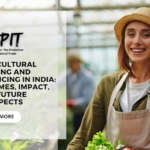
The fashion industry is a massive industry that plays an essential role in the global economy, generating billions of dollars in revenue annually. However, the industry is also known for its significant impact on the environment and society, such as water pollution, greenhouse gas emissions, and labor exploitation. Sustainable fashion is an approach that seeks to minimize the negative impact of the fashion industry while promoting economic, social, and environmental sustainability. In this case study, we will explore the sustainable fashion landscape in India, one of the world’s leading textile producers, and the challenges, solutions, and opportunities for sustainable fashion in the country.
Sustainable Fashion Landscape in India: India is the second-largest producer of textiles globally and has a rich history of textile production that dates back to ancient times. The Indian textile industry employs millions of people, making it one of the most significant contributors to the country’s economy. However, the industry is also responsible for significant environmental degradation and labor exploitation. In recent years, there has been a growing awareness of the need for sustainable fashion in India, with many brands and entrepreneurs focusing on creating eco-friendly and socially responsible fashion products.
Challenges: Sustainable fashion is a complex and multifaceted issue that encompasses environmental, social, and economic considerations. While the concept of sustainable fashion is gaining traction globally, there are still numerous challenges that need to be addressed to achieve a more sustainable future for the fashion industry. In India, the textile industry is a significant contributor to the country’s economy, but it also poses significant environmental and social challenges. From water pollution to exploitative labor practices, the challenges facing sustainable fashion in India are diverse and require urgent attention. This section will explore ten top and unique challenges that India faces in its quest for more sustainable fashion, including statistics to highlight the scale of the problem. By identifying these challenges, we can begin to develop strategies and solutions to create a more sustainable fashion industry in India.
- Water Pollution: The textile industry is one of the most water-intensive industries globally, with a significant amount of water being used in every stage of the production process. The untreated effluent discharged from textile mills is a significant source of water pollution in India. According to a study by the Central Pollution Control Board (CPCB), the textile industry is responsible for 17-20% of industrial water pollution in India.
- Chemical Use: The use of toxic chemicals in textile production, such as dyes, finishes, and bleaches, poses a significant environmental and health hazard. These chemicals can leach into waterways, causing contamination and harm to human health. According to a report by the Centre for Science and Environment (CSE), the textile industry is the third-largest water polluter in India, with chemical use being a significant contributor.
- Waste Management: The textile industry generates a considerable amount of waste, such as fabric scraps, trimmings, and production waste. The improper disposal of textile waste can lead to environmental pollution, such as landfills and waterways. According to a report by the Ministry of Textiles, India generates approximately 16 million tons of textile waste every year.
- Exploitative Labor Practices: The textile industry in India is known for its exploitative labor practices, such as low wages, long working hours, and unsafe working conditions. According to a report by the India Committee of the Netherlands, there are approximately 10-12 million child laborers in India, with a significant number working in the textile industry.
- Lack of Transparency: The lack of transparency in the textile industry supply chain makes it challenging to identify and address environmental and social issues. Many textile companies in India do not disclose information about their sourcing and production practices, making it difficult for consumers to make informed purchasing decisions.
- Lack of Awareness: The lack of awareness among consumers about sustainable fashion and its importance is a significant challenge. Many consumers in India are price-sensitive and prioritize affordability over sustainability, making it difficult for sustainable fashion brands to compete with conventional brands.
- Low Availability of Sustainable Materials: The availability of sustainable materials in India is limited, making it challenging for sustainable fashion brands to source materials locally. Most sustainable materials are imported, making them expensive and less accessible for small-scale entrepreneurs.
- High Cost of Sustainable Production: The high cost of sustainable production is a significant challenge for sustainable fashion brands in India. Sustainable production practices, such as using organic materials and paying fair wages, can increase production costs significantly, making it difficult for small-scale entrepreneurs to compete with larger, conventional brands.
- Lack of Government Support: The lack of government support for sustainable fashion is a significant challenge. There are no specific policies or initiatives to promote sustainable fashion in India, making it difficult for entrepreneurs to access funding and resources.
- Fast Fashion Culture: The fast fashion culture in India, where consumers prioritize trends and quick turnover of clothing, is a significant challenge for sustainable fashion. Fast fashion brands produce clothing quickly and cheaply, making it difficult for sustainable fashion brands to compete with their low prices and quick production turnaround.
Overall, these challenges demonstrate the need for significant changes in the textile industry in India towards more sustainable practices.
Solutions Implemented by the Country: To address the challenges facing sustainable fashion in India, numerous solutions have been implemented to promote sustainable textile production and responsible consumption. These solutions range from using sustainable materials and natural dyes to circular fashion and ethical labor practices. Sustainable fashion brands in India are also collaborating with local artisans, raising awareness about sustainable fashion, and implementing sustainable packaging solutions. In addition, the Indian government has launched several initiatives to support sustainable fashion entrepreneurs and promote sustainable textile production. This section will explore 10 top and unique solutions implemented for sustainable fashion in India, highlighting the positive impact they have on the environment, society, and the fashion industry.
- Use of Sustainable Materials: Sustainable fashion brands in India are increasingly using sustainable materials such as organic cotton, bamboo, and recycled polyester. According to a report by the Textile Exchange, India is the second-largest producer of organic cotton globally, accounting for 20% of global production.
- Recycling and Upcycling: Recycling and upcycling are popular solutions to address textile waste in India. Several sustainable fashion brands in India are using textile waste to create new products, such as bags and accessories. According to a report by the Ministry of Textiles, India recycles approximately 60% of its textile waste.
- Handloom and Handicrafts: Handloom and handicrafts are traditional methods of textile production in India and are considered sustainable as they require minimal energy and water. Sustainable fashion brands in India are incorporating handloom and handicrafts into their designs, supporting local artisans and preserving traditional textile techniques.
- Ethical Labor Practices: Ethical labor practices are becoming increasingly important in the fashion industry, with several sustainable fashion brands in India paying fair wages and providing safe working conditions for their workers. According to a report by the International Labour Organization (ILO), India has made significant progress in reducing child labor in the textile industry.
- Use of Natural Dyes: Natural dyes are an environmentally friendly alternative to synthetic dyes, which can be harmful to the environment and human health. Several sustainable fashion brands in India are using natural dyes made from plants and herbs, reducing the use of toxic chemicals in textile production.
- Circular Fashion: Circular fashion is a closed-loop system that aims to reduce waste and extend the life cycle of clothing. Sustainable fashion brands in India are implementing circular fashion solutions, such as take-back programs and repair services, to reduce textile waste.
- Awareness Campaigns: Awareness campaigns are essential to educate consumers about sustainable fashion and its impact on the environment and society. Sustainable fashion brands in India are partnering with NGOs and government organizations to raise awareness about sustainable fashion and promote responsible consumption.
- Collaboration with Artisans: Collaborating with local artisans is a sustainable solution for fashion production as it supports the local economy and preserves traditional skills. Several sustainable fashion brands in India are partnering with local artisans to create unique and sustainable products.
- Sustainable Packaging: Sustainable packaging is an important aspect of sustainable fashion, with several brands in India using eco-friendly materials such as recycled paper and biodegradable plastics. According to a report by the Ministry of Environment, Forest and Climate Change, India generates approximately 26,000 tons of plastic waste every day, highlighting the need for sustainable packaging solutions.
- Government Initiatives: The Indian government has launched several initiatives to promote sustainable fashion, such as the Sustainable Fashion and Indian Textiles (SUIT) initiative and the Handloom and Handicrafts Development Programme. These initiatives aim to support sustainable fashion entrepreneurs and promote sustainable textile production.
These solutions demonstrate the potential for sustainable fashion in India and the efforts being made to create a more sustainable fashion industry. By implementing these solutions, India can move towards a more sustainable and responsible fashion industry.
Opportunities for entrepreneurs: Sustainable fashion is not just an important movement for preserving the environment, but it also presents significant opportunities for entrepreneurs in India. As more consumers are becoming conscious of the impact of their fashion choices, there is an increasing demand for sustainable fashion products that offer eco-friendliness, social responsibility, and ethical manufacturing practices. This demand is driving entrepreneurs to create innovative and sustainable fashion solutions, from materials to production and distribution. In this section, we will explore 10 top and unique opportunities for entrepreneurs to solve the issues of sustainable fashion in India.
- Innovative Sustainable Materials: Entrepreneurs can explore the use of innovative sustainable materials such as banana fibers, milk proteins, and recycled PET bottles. India’s abundance of natural resources provides ample opportunities for entrepreneurs to experiment with sustainable materials and create unique sustainable fashion products.
- Circular Fashion Business Models: Entrepreneurs can develop circular fashion business models that prioritize reducing waste and increasing product longevity. Take-back programs, rental services, and repair and refurbishment services are examples of circular fashion business models that can create sustainable revenue streams for entrepreneurs.
- Ethical Fashion Marketplace: Entrepreneurs can create ethical fashion marketplaces that bring together sustainable fashion brands and connect them with conscious consumers. Such marketplaces can promote responsible consumption and create awareness around sustainable fashion.
- Zero Waste Fashion: Entrepreneurs can focus on zero-waste fashion by repurposing textile waste and creating new products. This can lead to the creation of a circular economy where waste is reduced and resources are conserved.
- Sustainable Manufacturing: Entrepreneurs can focus on sustainable manufacturing practices such as using renewable energy sources and reducing water and energy consumption. Such practices can create sustainable manufacturing facilities and contribute to the growth of the sustainable fashion industry.
- Upcycling and Customization: Entrepreneurs can explore upcycling and customization of existing products to create unique sustainable fashion products. This can lead to the creation of a personalized and sustainable fashion industry.
- Local Sourcing and Production: Entrepreneurs can focus on local sourcing and production of materials and products to reduce the carbon footprint and support local communities. This can create a localized sustainable fashion industry that benefits the local economy and environment.
- Green Packaging: Entrepreneurs can explore the use of green packaging solutions such as biodegradable and compostable packaging. Such solutions can reduce the environmental impact of packaging and promote sustainable fashion.
- Sustainable Supply Chain Management: Entrepreneurs can focus on sustainable supply chain management practices such as fair labor practices and reducing the carbon footprint. Such practices can create a sustainable supply chain and promote sustainable fashion.
- Sustainable Fashion Education: Entrepreneurs can create sustainable fashion education programs to create awareness and promote responsible consumption. Such programs can educate consumers and create a demand for sustainable fashion products.
These opportunities present immense potential for entrepreneurs in India to create sustainable fashion solutions that are eco-friendly, socially responsible, and ethically manufactured. By taking advantage of these opportunities, entrepreneurs can contribute to the growth of the sustainable fashion industry in India and promote a more sustainable future.
Outcome of the Solutions Implemented: The implementation of sustainable fashion solutions in India has led to several positive outcomes for the environment, society, and the fashion industry. These outcomes range from reducing carbon emissions to promoting ethical labor practices and responsible consumption. Sustainable fashion solutions have also led to the creation of innovative business models and a more diverse and inclusive fashion industry.
10 top and unique outcomes of sustainable fashion solutions in India.
- Reduction in Carbon Emissions: Sustainable fashion solutions have led to a reduction in carbon emissions by promoting eco-friendly materials and production processes. This has helped to reduce the fashion industry’s impact on the environment and mitigate climate change.
- Preservation of Natural Resources: The use of sustainable materials and production processes has helped to preserve natural resources such as water and energy. This has led to a more sustainable fashion industry that conserves resources for future generations.
- Promotion of Ethical Labor Practices: Sustainable fashion solutions have promoted ethical labor practices such as fair wages and safe working conditions for workers. This has helped to improve the lives of workers and promote social justice.
- Increase in Responsible Consumption: Sustainable fashion solutions have created awareness among consumers about the impact of their fashion choices on the environment and society. This has led to an increase in responsible consumption and a demand for sustainable fashion products.
- Growth of Circular Economy: Sustainable fashion solutions have led to the growth of a circular economy where waste is reduced and resources are conserved. This has created new business opportunities and revenue streams for entrepreneurs in the sustainable fashion industry.
- Promotion of Diversity and Inclusion: Sustainable fashion solutions have promoted diversity and inclusion in the fashion industry by creating opportunities for local artisans and marginalized communities. This has led to a more diverse and inclusive fashion industry that celebrates different cultures and traditions.
- Improvement in Supply Chain Transparency: Sustainable fashion solutions have improved supply chain transparency by promoting responsible sourcing and production practices. This has helped to reduce the environmental and social impact of the fashion industry.
- Creation of Innovative Business Models: Sustainable fashion solutions have led to the creation of innovative business models such as circular fashion and upcycling. This has created new revenue streams and opportunities for entrepreneurs in the sustainable fashion industry.
- Adoption of Green Packaging Solutions: Sustainable fashion solutions have led to the adoption of green packaging solutions such as biodegradable and compostable packaging. This has reduced the environmental impact of packaging and promoted sustainable fashion.
- Development of Sustainable Fashion Education: Sustainable fashion solutions have led to the development of sustainable fashion education programs that create awareness and promote responsible consumption. This has helped to educate consumers and create a demand for sustainable fashion products.
These outcomes demonstrate the positive impact of sustainable fashion solutions in India. By promoting eco-friendly materials, ethical labor practices, and responsible consumption, sustainable fashion solutions have created a more sustainable fashion industry that is focused on preserving the environment and promoting social justice. These outcomes also present opportunities for entrepreneurs in the sustainable fashion industry to create innovative and sustainable solutions that contribute to a more sustainable future.
Implication of Private-public partnerships, alliances, and collaborations on country’s sustainable fashion sector: Private-public partnerships, alliances, and collaborations have played a crucial role in promoting sustainable fashion in India. The fashion industry is complex and requires a multidisciplinary approach to achieve sustainability goals. Private-public partnerships, alliances, and collaborations have brought together different stakeholders such as government, industry, NGOs, and consumers to work towards a common goal of creating a sustainable fashion industry.
-
Improved Access to Resources: Private-public partnerships, alliances, and collaborations have improved access to resources for sustainable fashion initiatives. For example, the Sustainable Apparel Coalition is a global alliance of apparel, footwear, and home textile companies that work towards reducing the environmental and social impacts of the fashion industry. The coalition provides tools and resources to help companies measure and improve their sustainability performance.
- Increased Funding: Private-public partnerships, alliances, and collaborations have increased funding for sustainable fashion initiatives. For instance, the United Nations Development Programme has partnered with the Indian government to launch the Green Good Deeds campaign, which aims to promote sustainable living and consumption. The campaign is supported by private sector partners who have pledged funding and resources to support the initiative.
- Shared Expertise: Private-public partnerships, alliances, and collaborations have facilitated the sharing of expertise and knowledge across different sectors. For example, the Sustainable Fashion Forum is an initiative that brings together stakeholders from the fashion industry, academia, and civil society to share best practices and promote sustainable fashion. The forum provides a platform for stakeholders to exchange ideas and collaborate on sustainable fashion initiatives.
- Improved Policy Framework: Private-public partnerships, alliances, and collaborations have helped to improve the policy framework for sustainable fashion. For instance, the Ministry of Textiles in India has launched the Sustainable and Accelerated Adoption of Efficient Textile Technologies (SAATAT) initiative, which aims to promote sustainable textile production in the country. The initiative is supported by private sector partners who provide technical expertise and funding.
- Increased Consumer Awareness: Private-public partnerships, alliances, and collaborations have increased consumer awareness about sustainable fashion. For instance, the Better Cotton Initiative is a global alliance of cotton producers, textile mills, and retailers that work towards improving cotton production practices. The initiative has helped to increase awareness among consumers about the importance of sustainable cotton production.
Key statistics:
- The Sustainable Apparel Coalition has over 250 members, including major brands such as Adidas, Nike, and Levi’s.
- The Green Good Deeds campaign has received pledges of over INR 20 billion from private sector partners.
- The Sustainable Fashion Forum has over 3,000 members, including designers, academics, and civil society organizations.
- The SAATAT initiative has received funding of over INR 500 crore from private sector partners.
- The Better Cotton Initiative has over 2,100 members, including major retailers such as H&M and Ikea.
Private-public partnerships, alliances, and collaborations have significant implications for promoting sustainable fashion in India. These partnerships bring together different stakeholders and resources to work towards a common goal of creating a sustainable fashion industry. They have helped to improve access to resources, increase funding, share expertise, improve the policy framework, and increase consumer awareness about sustainable fashion. These partnerships have also been supported by major private sector players, indicating a growing recognition of the importance of sustainable fashion in the industry.
Conclusion: The fashion industry is one of the largest and most influential industries in the world, but it is also one of the most environmentally and socially damaging industries. Sustainable fashion is a way to address these issues and create a more responsible and ethical industry. India, being one of the major textile and clothing manufacturing hubs in the world, faces significant challenges and opportunities to promote sustainable fashion.
In this report, we have discussed the top challenges faced by India in promoting sustainable fashion, including issues such as resource depletion, unethical labor practices, and poor waste management. However, we have also highlighted the various solutions that have been implemented to address these challenges. From the use of sustainable materials and manufacturing practices to the promotion of ethical labor practices and waste reduction, India is making strides towards a more sustainable fashion industry.
We have also highlighted the various opportunities available for entrepreneurs to promote sustainable fashion in India. These opportunities include the use of sustainable materials, innovative production processes, and the development of new business models. With the growing demand for sustainable fashion, entrepreneurs have the opportunity to capitalize on this trend and create a more responsible and ethical fashion industry.
Finally, we have discussed the implications of private-public partnerships, alliances, and collaborations on sustainable fashion in India. These partnerships have brought together different stakeholders, including government, industry, NGOs, and consumers, to work towards a common goal of creating a sustainable fashion industry. These partnerships have helped to improve access to resources, increase funding, share expertise, improve the policy framework, and increase consumer awareness about sustainable fashion.
The progress made by India towards sustainable fashion is impressive, but there is still much work to be done. It is essential that all stakeholders continue to work together towards a more sustainable and ethical fashion industry. The fashion industry has a significant impact on the environment and society, and it is our responsibility to ensure that it is a positive impact.
According to a report by Global Fashion Agenda, the fashion industry produces 92 million tons of textile waste every year, and the industry is responsible for 10% of global carbon emissions. Furthermore, the fashion industry is one of the largest water consumers, with an estimated 79 billion cubic meters of water used in textile production every year. These statistics highlight the urgency of promoting sustainable fashion in India and globally.
However, there are also significant economic benefits to promoting sustainable fashion. A report by the Ellen MacArthur Foundation estimates that a transition to a circular fashion industry could generate USD 218 billion in economic value by 2030. Furthermore, a report by Boston Consulting Group estimates that the Indian fashion industry could create 10 million new jobs and increase its contribution to GDP from 2% to 8% by 2025 by promoting sustainable fashion.
Promoting sustainable fashion in India is not only a moral imperative but also an economic opportunity. It is essential that all stakeholders work together to address the challenges and opportunities of sustainable fashion. By doing so, we can create a more responsible, ethical, and prosperous fashion industry for the future.
Call to action: As a Global Alliance for Sustainable Fashion, we call on all stakeholders in the fashion industry to collaborate and work towards a more sustainable and ethical fashion industry in India and globally. The challenges we face, from resource depletion to unethical labor practices and poor waste management, are significant and urgent. However, we believe that together, we can create a positive impact on the health and wellbeing of our planet and its people.
We urge fashion brands and manufacturers to adopt sustainable materials and manufacturing practices, reduce waste, and promote ethical labor practices. We also call on retailers and consumers to support sustainable fashion by making informed purchasing decisions and demanding greater transparency from brands.
Furthermore, we call on governments to support sustainable fashion by creating a policy framework that promotes sustainability and ethical labor practices, provides funding for sustainable initiatives, and supports circular business models.
We encourage NGOs and industry associations to work together to share expertise, improve access to resources, and promote sustainable fashion globally.
Finally, we call on all stakeholders to increase their efforts to promote sustainable fashion education and awareness. We believe that by educating consumers about the benefits of sustainable fashion, we can create a demand for more sustainable and ethical products.
Together, we can create a more sustainable and ethical fashion industry that promotes the good health and wellbeing of our planet and its people. Let us work together towards this common goal and make a positive impact on the world we live in.
References:
- “India’s Fashion and Textile Industry: Fueling Growth, Creating Jobs.” World Bank. https://www.worldbank.org/en/news/feature/2017/04/05/indias-fashion-and-textile-industry-fueling-growth-creating-jobs.
- “India’s Sustainable Fashion Brands.” Ethical Fashion Initiative. https://ethicalfashioninitiative.org/indias-sustainable-fashion-brands/.
- “Sustainable Textiles: A Better Future for Fashion.” United Nations Industrial Development Organization. https://www.unido.org/news/sustainable-textiles-better-future-fashion.
- “India’s Fashion Industry: Sustainability Through Innovation.” The Diplomat. https://thediplomat.com/2020/01/indias-fashion-industry-sustainability-through-innovation/.
- “Circular Fashion in India: The Road Ahead.” The Better India. https://www.thebetterindia.com/228012/circular-fashion-in-india-the-road-ahead/.
- “Sustainable Fashion in India: The Road Ahead.” Business World. https://www.businessworld.in/article/Sustainable-Fashion-In-India-The-Road-Ahead/06-08-2020-307392/.
- “5 Ways India Can Lead the Way in Sustainable Fashion.” Eco-Age. https://eco-age.com/news/5-ways-india-can-lead-way-sustainable-fashion.
- “The Indian Textile and Clothing Industry: An Overview.” Textile Today. https://www.textiletoday.com.bd/the-indian-textile-and-clothing-industry-an-overview/.
- “Ethical Fashion Brands in India: A Sustainable Trend.” Kalkine Media. https://kalkinemedia.com/in/special-series/ethical-fashion-brands-in-india-a-sustainable-trend.
- “Sustainable Fashion: The Indian Connection.” The Economic Times. https://economictimes.indiatimes.com/industry/cons-products/fashion-/-cosmetics-/-jewellery/sustainable-fashion-the-indian-connection/articleshow/71569847.cms.








